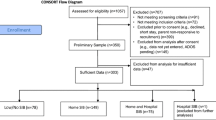Abstract
Staff agreement on the identification of 18 different types of self-injurious behavior (SIB) and the prevalence of SIB were assessed in a population of 91 severely and profoundly retarded residents in a large facility for mentally retarded people in West Germany (FRG). The survey included 27 direct care staff; groups of three to five rated the behavior of 8 to 27 residents from their own wards. Agreement was calculated with two different formulas for multiple raters. The data suggest that the standard definition of SIB [Tate, B. G.,& Baroff, G. S. (1966).Behavior Research and Therapy, 4, 281–287], together with a list of the most common SIB topographies, yields variable and generally low staff agreement. The data for the prevalence statistics were derived from cases in which at least 50% of the staff had indicated the occurrence of an SIB topography in a resident. Sixty of the 91 residents exhibited some form of SIB; of these, 15 demonstrated only one type, 12 two, and 33 three or more SIB topographies. The data corroborate the notion of the two taxonomic classes of “social and “nonsocial” SIB. Contrary to other classifications the data indicate that “ruminative vomiting” belongs to the social SIB class.
Similar content being viewed by others
References
Cranach, M. von, & Wittchen, H. U. (1980). Epidemiologische Aspekte der Evaluationsforschung in der psychiatrischen Versorgung. In S. Biefang (Ed.),Evaluations forschung in der Psychiatrie: Fragestellungen und Methoden (pp. 208–249). Stuttgart: Enke.
Danford, D. E., & Huber, A. E. (1982). Pica among mentally retarded.American Journal of Mental Deficiency, 87 141–146.
Favell, J. E., Azrin, N. H., Baumeister, A. A., Carr, E. G., Dorsey, M. F., Forehand, R., Foxx, R. M., Lovaas, O. I., Rincover, A., Risley, I. R., Romanczyk, R. G., Russo, D. C., Schroeder, S. R., & Solnick, J. V. (1982). The treatment of self-injurious behavior.Behavior Therapy, 13 529–554.
Grossman, J. H. (Ed.) (1977).Manual on terminology and classification in mental retardation. Washington, DC: American Association on Mental Deficiency.
Hollis, J. H., & Meyers, C. E. (Eds.). (1982).Life-threatening behavior: Analysis and intervention. Washington, DC: American Association on Mental Deficiency.
House, A. E., House, B. T., & Campbell, M. B. (1981). Measures of interobserver agreement: Calculation formulas and distribution effects.Journal of Behavioral Assessment, 3 37–57.
Maisto, C. R., Baumeister, A. A., & Maisto, A. A. (1978). An analysis of variables related to self-injurious behavior among individualized retarded persons.Journal of Mental Deficiency Research, 22 27–36.
Maurice, P., & Trudel, G. (1982). Self-injurious behavior prevalence and relationship to environment events. In J. H. Hollis & C. E. Meyers (Eds.),Life-threatening behavior: Analysis and intervention (pp. 81–103). Washington, DC: American Association on Mental Deficiency.
Mulick, J. A., Schroeder, S. R., & Rojahn, J. (1980). Chronic ruminative vomiting: A comparison of four treatment procedures.Journal of Autism and Developmental Disorders, 10 203–213.
Schroeder, S. R., Mulick, J. A., & Rojahn, J. (1980). The definition, taxonomy, epidemiology, and ecology of self-injurious behavior.Journal of Autism and Developmental Disorders, 10 417–432.
Schroeder, S. R., Schroeder, C. S., Smith, B., & Dalldorf, J. (1978). Prevalence of self-injurious behaviors in a large state facility for the retarded: A three-year follow-up study.Journal of Autism and Childhood Schizophrenia, 8 261–269.
Singh, N. N. (1981). Rumination. In N. R. Ellis (Ed.),International review of research in mental retardation, Vol. 10 (pp. 139–182). New York: Academic Press.
Tate, B. G., & Baroff, G. S. (1966). Aversive control of self-injurious behavior in a psychotic boy.Behavior Research and Therapy, 4 281–287.
Author information
Authors and Affiliations
Additional information
The author wishes to express his gratitude to Dr. Udo Lück, chief psychologist of the Diakoniezentrum Hephata, who made this study possible by his interest and support. The help of Walter Edlinger in collecting the data and of Prof. Hartmann Scheiblechner in giving methodological advice is also greatly appreciated.
Rights and permissions
About this article
Cite this article
Rojahn, J. Self-injurious behavior in institutionalized, severely/profoundly retarded adults—Prevalence data and staff agreement. Journal of Behavioral Assessment 6, 13–27 (1984). https://doi.org/10.1007/BF01321457
Accepted:
Issue Date:
DOI: https://doi.org/10.1007/BF01321457




